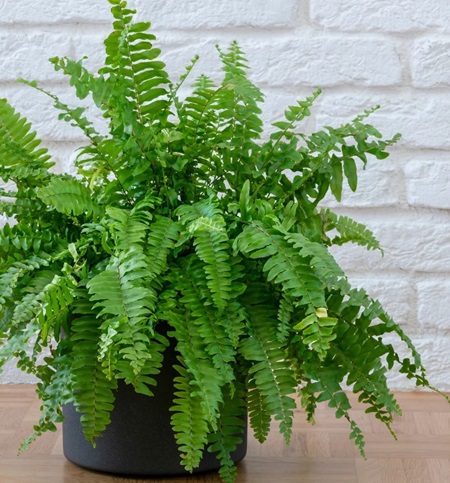Ferns are some of the most popular and versatile houseplants, known for their lush, delicate fronds and ability to add a touch of nature to indoor spaces. While there are many varieties of ferns, some are especially well-suited to life indoors. This article will explore three common types of ferns often kept as houseplants—Boston Fern, Bird’s Nest Fern, and Maidenhair Fern—and provide tips on how to care for them so they thrive in your home.
1. Boston Fern (Nephrolepis exaltata)
The Boston Fern is one of the most well-known houseplant ferns, celebrated for its arching fronds and feathery, green foliage. This fern thrives in humid conditions and is relatively low maintenance when placed in the right environment.

Care Tips for Boston Fern
Light: Boston Ferns prefer bright, indirect light. They can tolerate lower light conditions but may not grow as vigorously. Avoid direct sunlight, which can scorch the delicate fronds.
Watering: Keep the soil consistently moist but not soggy. Water thoroughly when the top layer of soil feels slightly dry. These ferns don’t like to dry out completely, so regular watering is essential. If the air in your home is dry, you might also want to mist the plant or place a humidity tray nearby to increase moisture levels.
Humidity: High humidity is key to keeping Boston Ferns healthy. They thrive in rooms with 50-60% humidity or more, making them ideal for bathrooms or kitchens where the air is naturally more humid. Alternatively, you can use a humidifier or mist the plant regularly.
Temperature: Boston Ferns do best in temperatures between **60-75°F (16-24°C)**. Avoid placing them near drafts or heating vents, as they prefer stable temperatures and dislike extreme heat or cold.
2. Bird’s Nest Fern (Asplenium nidus)
The Bird’s Nest Fern is unique among ferns because of its broad, wavy fronds that grow from a central rosette, giving the plant the appearance of a bird’s nest. It’s a hardy houseplant that can tolerate a range of conditions, making it great for beginners.
Care Tips for Bird’s Nest Fern
Light: Bird’s Nest Ferns thrive in medium to low indirect light. They can handle less light than other ferns, making them ideal for rooms that don’t get a lot of sunlight. Direct sunlight can scorch their leaves, so avoid placing them in bright, sunny windows.
Watering: Keep the soil consistently moist, but allow the top inch of soil to dry slightly between waterings. Be careful not to let water sit in the central rosette of the plant, as this can lead to rot. Watering from below or around the base of the plant is ideal.
Humidity: Like other ferns, Bird’s Nest Ferns enjoy high humidity. They can adapt to normal household humidity levels but will thrive in areas where humidity is higher. A humidity level above 50% is ideal. Misting and placing the fern in a naturally humid environment (like a bathroom) can help it flourish.
Temperature: Bird’s Nest Ferns prefer temperatures between 65-80°F (18-27°C). Keep them away from drafts, radiators, and air conditioning vents to prevent sudden changes in temperature.
3. Maidenhair Fern (Adiantum)
The Maidenhair Fern is prized for its soft, delicate leaves and finely textured fronds. While these ferns are beautiful and elegant, they can be more challenging to care for due to their particular needs, especially when it comes to humidity and watering.
Care Tips for Maidenhair Fern
Light: Maidenhair Ferns prefer bright, indirect light. They can tolerate lower light but need good light exposure to maintain their characteristic lush growth. Keep them away from direct sunlight, which can dry out and damage the delicate fronds.
Watering: This fern is especially sensitive to dry conditions, so maintaining consistent moisture is critical. The soil should be kept consistently moist but not waterlogged. Water the fern when the top layer feels slightly dry. Maidenhair ferns can quickly wilt if left without water for too long, but they can often recover with proper care.
Humidity: High humidity is essential for Maidenhair Ferns to thrive. Aim for humidity levels above 60%, and consider misting the plant frequently or placing it in a more humid environment, such as a bathroom. A humidity tray can also be beneficial to maintain the right moisture levels around the plant.
Temperature: These ferns prefer cooler temperatures, ideally between 60-75°F (16-24°C). Like other ferns, they don’t tolerate drafts, extreme heat, or cold. Keeping them in a stable, temperate environment will help ensure their health.
General Fern Care Tips
Regardless of the type of fern, there are some common care tips that apply to most indoor ferns:
Potting and Soil: Use a well-draining, peat-based potting mix to help retain moisture without becoming waterlogged. Ferns like soil that is both airy and retains moisture.
Fertilizing: Feed ferns with a balanced, diluted houseplant fertilizer during the growing season (spring and summer) to promote healthy growth. Be careful not to over-fertilize, as ferns are sensitive to buildup in the soil.
Pruning: Regularly remove any brown or dead fronds to encourage new growth and keep the plant looking its best. Brown tips can be an indication of low humidity or inconsistent watering.
Conclusion
Caring for ferns as houseplants can be highly rewarding, as they bring a sense of tranquility and natural beauty into your home. Whether you choose the hardy and adaptable Boston Fern, the low-maintenance Bird’s Nest Fern, or the more delicate Maidenhair Fern, understanding their individual needs for light, water, and humidity will help you keep these plants healthy and thriving. With the right care, these ferns can become long-lasting, graceful additions to your indoor plant collection.



Comment here